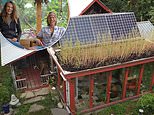
Talk about going back to basics.
With little money to their names, one couple from Ontario, Canada, have told how they turned to living off-grid in a cabin they built from scratch using salvaged materials.
Joel and Stephanie detailed their extraordinary story via the popular YouTube channel Exploring Alternatives.
While giving a tour of their characterful property – which has now been their labor of love for 15 years – the duo reveal that it cost just $5,000 to build using scraps from a local dump and a tumbledown barn.
With little money to their names, Joel and Stephanie from Ontario, Canada, built cabin from scratch using salvaged materials
While giving a tour of their characterful property – which has now been their labor of love for 15 years – the duo reveal that it cost just $5,000 to build
The outhouse was the very first structure on the plot, and Joel said he built it using ‘very minimal tools’
The first season the couple lived in their home it was partially built, so Joel says there were still ‘gaps’ in the structure and they had to ‘tough it out in the winter time’
Gradually their home took shape and after making do with candlelight for some time, they went about getting power.
The total spend included an array of new tools, with drills, lathes and hammers put into action.
The outhouse was the very first structure on the plot, and Joel said he built it using ‘very minimal tools.’
After that, the couple set to work building their home with their grand designs including a master bedroom in the loft, a main-floor bedroom, an open-plan kitchen, dining and living room area and a bathroom.
Stephanie explains to viewers in the YouTube clip, which was aired in October 2022: ‘We had no money. We were salvaging from the dump.
‘There was an old barn on the property that we took apart piece by piece and de-nailed all the boards and all that.
‘You know, that was a huge project. We built our place out of… whatever was salvaged at the dump and whatever we could get our hand on for free.’
The first season the couple lived in their home it was partially built, so Joel says there were still ‘gaps’ in the structure and they had to ‘tough it out in the winter time.’
Gradually their home took shape and after making do with candle light for some time, they went about getting power.
Stephanie said: ‘So we went from candlelight and then finally we got our first solar panel with a little marine deep cycle battery.
‘We used this for a couple of years. Then [we got] lights and then, from there we just expanded. We bought more solar panels.’
Today the couple have five 320 watt solar panels hooked up to four lithium batteries to store the excess power and during the winter months, when there is less sunlight, they use a generator.
Today the couple have five 320 watt solar panels hooked up to four lithium batteries to store the excess power and during the winter months they use a generator
In terms of their water supply, there is a well on the property for drinking water and they pump water from a neighboring reservoir for washing the dishes and for bathing
The home features a master bedroom in the loft and another on the main floor which has been split into two for the couple’s children
The couple say they would like to learn more about foraging, so that they can instantly identify ‘mushrooms, medicinals and herbs’
In terms of their water supply, there is a well on the property for drinking water and they pump water from a neighboring reservoir for washing the dishes and for bathing.
Instead of a flushable toilet, they have a composting toilet to save water and they still use their original outhouse.
On the food side of things, the couple grow much of their own produce.
Stephanie says: ‘We have three big communal gardens, we plant corn and we have raspberries in there and we have potatoes and tomatoes and peppers and cucumbers and squash.’
Meanwhile, Joel adds: ‘On this property we raise and produce all sorts of vegetables, meats, milk, honey, grapes, fruit, juices, wines… We’re very rich in food.’
The couple say they would like to learn more about foraging, so that they can instantly identify ‘mushrooms, medicinals and herbs.’
‘We want to teach other people. So we’d like to hold workshops, that include those things,’ Stephanie continues.
When it comes to earning an income, Joel works as an arborist, while Stephanie runs an off-grid Airbnb which they also built themselves. Since living off-grid they have also started a family, and their two children now share the bedroom space on the main floor.
Summing up the off-grid lifestyle, Stephanie concludes: ‘There’s so much satisfaction that has come out of our off-grid lifestyle.
‘There’s that satisfaction that we built the house that we live in.
‘We love the satisfaction that you get from growing your own food.
‘That makes it all worth while… We’ve spent a lot of time farming, experimenting, doing all these things and then we’ve gotten to the point now where we’re just trying to step back a little bit from those intensive things and just starting to enjoy our lives together with our children.’
Source link
CHECK OUT: Top Travel Destinations
READ MORE: Travel News



